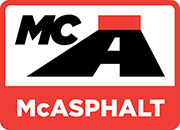Dense Graded Sealcoat
A graded aggregate seal is a seal coating that uses a well-graded aggregate rolled into a high-float, emulsified asphalt, also known as a dense-graded seal. A typical gradation is 98% less than 16 mm, with 2%–7% passing the 75 mm sieve. Aggregate gradation determines the application rate of the emulsion.
Design Criteria
When designing a chip seal a number of factors have to be examined and assessed to ensure a proper surface will be placed that will perform for its service life. The following factors can have a tremendous effect on the performance of a chip seal; traffic, aggregate shape, specific gravity of the aggregate, aggregate wastage, residual asphalt content. If these factors are addressed the chances of a good chip seal being placed are greatly increased.
Traffic:
The type and quantity of traffic will have a large effect on the amount of asphalt emulsion to be used as well as the emulsion type. The lower the traffic volume the softer the grade of high float emulsion.
Aggregate Shape:
The overall shape of the cover aggregate can influence the quantity of aggregate as well as the amount of asphalt emulsion to be used. The larger the aggregate size the higher the emulsion quantity needed. The gradation can also influence the spray rate needed.
Specific Gravity of Cover Aggregate:
The bulk specific gravity of the cover aggregate will affect the quantity of aggregate needed. The higher the specific gravity the more aggregate is needed and vice versa.
Aggregate Wastage:
In all dense graded seals an excess of cover aggregate has to be applied to offset the unevenness of spread and whip-off by traffic. Depending on the chip spreader equipment the excess amount can vary from 2 to 10 percent but is typically 5 percent.
Asphalt Residual in the Emulsion:
The quantity of asphalt residual in the emulsion can affect the quantity of emulsion needed to hold the cover aggregate. The lower the residual the higher the quantity of asphalt emulsion needed.
If these factors are taken into consideration in designing the dense graded seal then the chances of a successful seal are greatly improved. Typically a dense graded seal would require an emulsion application rate of 1.5 – 1.8 l/sqm and a cover aggregate quantity of 16 to 22 kgs/sqm.
Materials – Recycling Additives
Asphalt Emulsions:
The asphalt emulsion grade used in dense graded seals is the medium setting high float type containing a small quantity of solvent. The use of solvent helps the asphalt to penetrate through the fine particles and a good bond between the emulsion residue and the aggregate. A number of different grades of high float emulsions can be used in dense graded seals. The proper emulsion to be used is based on a number of factors; environmental conditions (temperature and humidity), traffic volume and type, type of cover aggregate and the existing road surface conditions (slope, shade, hills and curves). All these conditions affect the emulsion to be used. Typically the most common emulsions used are HF150, HF150P, HF250, HF250P.
Cover Aggregate:
The type of cover aggregate used in dense graded seals must meet certain requirements of shape, size, cleanliness and surface properties. The aggregate should have a maximum size of 16.0 mm and have between 45 and 65% passing the 4.75 mm sieve size as well as having no more than 7% passing the 75 micron sieve size. The number of flat and elongated particles should be kept to a minimum so that the proper quantity of asphalt emulsion can be applied to hold the aggregate in place. Also the asphalt emulsion to be used and the aggregate must be compatible to ensure the asphalt-aggregate bond is effective.
Performance Guidelines
In order to construct a proper well designed dense graded seal the following guidelines should be followed:
- Assure the existing pavement structure is adequate to support expected traffic
- Design a dense graded seal with aggregate to be used on job
- Use a well graded aggregate
- Calibrate and inspect all equipment
- Use sufficient number and properly weighted rollers
- Follow proper construction techniques
- Use traffic control to protect seal
- Work only in weather suitable for type and grade of emulsion being used
